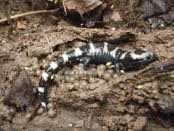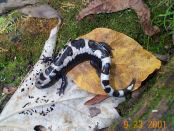Ambystoma opacum (Gravenhorst, 1807)



Key Characters: Stocky, black or gray body with whitish crossbands on back and tail; belly black, sometimes with white flecks.
Similar Species: Adults not likely to be confused with any other salamander.
Subspecies: None recognized.
Description: (modified from Smith, 1961) A medium-size (up to 120 mm TL), stout, black salamander with 3 to 8 bright white (male) to grayish white (female) crossbands on the back and 4 to 8 white rings around the tail; dorsal crossbands widened laterally, usually forming a pair of dorsolateral light stripes; head wide; toes of adpressed limbs touching to broadly overlapping. Before banded pattern develops on juveniles, the back is covered with scattered whitish or silvery frosting. Male has more protuberant cloacal region than female, especially during breeding season. Larva distinguished by uniform dark stippling on throat and sides of belly, and row of conspicuous clear spots on midsides.
Habitat: Mesic forests, dry hillsides, and moist floodplains. In autumn, adults migrate to wooded breeding areas, where they mate in dry pond basins or margins of ponds and swamps that will be flooded by autumn or winter rains.
Natural History: The largely subterranean adults are sometimes found under rocks and logs, especially during September-October, when they breed in dry pond basins. Each female lays 100-300 eggs in a loose cluster on land and curls protectively around them. The eggs hatch when covered with water from autumn rains. Larvae feed on microcrustaceans, insect larvae, snails, isopods, amphipods, and other aquatic invertebrates and transform the following April or May. Adults feed on beetles, centipedes, slugs, worms, and other invertebrates.
Status: Much suitable habitat remains in counties south of the Shelbyville Moraine, and some along the Vermilion River.
Etymology: Ambystoma – amblys (Greek) for blunt; -stoma (Greek) meaning mouth; or anabystoma (New Latin) meaning ‘to cram into the mouth’; opacum – opacus (Latin) for shady, dark, obscure, dim
Original Description: Gravenhorst, J. L. C. 1807. Vergleichende Uebersicht des Linneischen und einiger Neuern Zoologischen Systeme, nebst dem Eingeschaltenen Verzeichniss der Zoologischn Sammlung des Verfassers und den Beschreibungen neuer Theirarten die in Derselben Vorhanden Sind [Göttingen]: H. Dieterich.
Type Specimen: Not designated, but considered to be animal figured in pl. 10 of Gravenhorst, 1829, Delic. Mus. Zool. Vratislav., 1:75.
Type Locality: “Neuyork in Nordamerika” = New York, USA
Original Name: Salamandra opaca Gravenhorst, 1807.
Nomenclatural History: Other than being transferred from Salamandra to Ambystoma and its alternative spelling Amblystoma, the nomenclature of this species, at least in the Illinois literature, has been stable.


